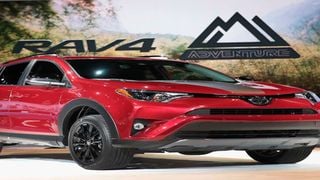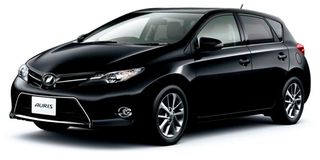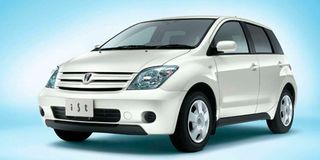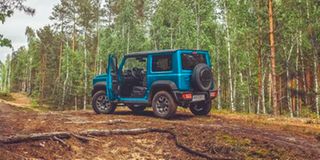
Toyota Rav 4
| PoolDN2
Premium
This reader wants the Toyota iST or Auris, but Baraza has a better suggestion…
What you need to know:
- Think outside the box, are your choices really limited to two vehicles only?
- Are both of them inappropriate for the job description you assign their office?
Hi JM,
Thanks for your very informative column on matters motoring. I am a beneficiary of your insight and advice on cars. Now, I am torn between getting a Toyota iST new model and an Auris.
I would like to know their engine capacity, which of the two is a better performer especially when offroading, the size of their wheels - do they require raising to get a better ground clearance, especially the iST?
What are their boot sizes like, for instance, can they fit a bag of charcoal from Mogotio which has the best in the world? I am really waiting for your expert advice so that l can immediately acquire the better one of the two
Wanyoike.
Hi Wanyoike,
Your question sounds awfully familiar, what with the iSTs and Aurises... Aures... Aura... what's the plural of an Auris anyway? On to your queries:
1. Engine capacity: the iST has the following engine capacities available, all four-cylinder petrol units (ignore the Eurocentric diesel): 1300, 1500 and 1800, rounded off to the nearest neat figure. The Auris has the exact same engines for the 1300 and the 1500, called the 1NR-FE and 1NZ-FE, respectively, but that's where the similarities end and the Auris diversifies its portfolio. The 1800 is the same 2ZR-FE as the one in the iST, but in the Auris it comes with Valvematic technology, changing its name to the 2ZR-FAE.
There is yet another engine in the Auris lineup, an interesting one, called the 8NR-FTS. It's a tiny little 1200 but with a turbo slapped onto it, seeing peaks of 114hp, which is the kind of figure one would expect from a 1.5 liter
2. Off-roading: don't. Just don't. I know I once mentioned how a fish monger acquaintance disciple of mine followed Prados off the wide and smooth into the barely tractable in his since-sold iST, but that was a first generation car, and more importantly, I do not recommend mimicking this behaviour. These cars are not meant for off-road use, which is why I will not even bother comparing their abilities. This is like asking between a hammer and a hacksaw which is better suited for frying fish. The answer is none of the above.

3. Wheel sizes: well, wheels are like the third most commonly changed item on a motor vehicle, after oil and filters - and maybe plugs, but Subaru ownership introduced me to the concept of 100,000km spark plugs so I may be a bit jaded here. The wheels are whatever size you want them to be. Off the factory floor, rim size will vary between 14 inches and 16, depending on the specification of the car, and from there the end user may go about changing these at will.
4. Raising the vehicle: maybe they require raising, maybe they don't. The intended use for these vehicles did not include applications where ground clearance needs a boost, otherwise they'd just be built taller from scratch, no?
5. Boot size: their respective boots will fit one bag of the best charcoal in the world, the little-known Mogotio Obsidian Firestarter ®©™ (this is a brand name I just made up and will be patenting it soon. You are welcome), but there are some underlying issues that will need to be addressed before. These issues are centered around what else is in the boot at that charcoal-loading juncture.

Toyota IST
The iST has a van-esque rear extension and perfectly vertical tailgate - meaning you can gamble with road safety and the displeasure of the feds by loading two bags of the finest Mogotio Obsidian into the rear hatch, something you cannot do with the more curvy Auris which went for titillating Instagram looks at the expense of charcoal-bearing usefulness.
Now, yours is an odd solution. Of the two cars, the easiest choice is the Auris: it looks better - far much better, it offers a wider and more interesting range of engines - with Valvematic, no less - including that interesting 1.2 liter turbo, it's better to drive, it will hold its value over the long term and will do everything the iST will do without looking like a wall unit designed by an uninspired carpenter.
It will do everything the iST will do except for two things you mention, which the iST may arguably excel at better than the Auris but was not designed for to begin with: toting bags of Mogotio Obsidian Conflagrator®©™ and driving over objects taller than 3 inches in height. So perhaps you want the iST after all...

Toyota Rav 4
Or not. Are your choices really limited to two vehicles only, both of them inappropriate for the job description you assign their office? Have you never heard of a Toyota RAV4? It will carry bags of Mogotio Obsidian FlameShop®©™ v1.1 without compunction and it will drive over objects taller than 3 inches in height without the need for suspension modification or worrying about wheel size. It will also hold its value even better than the Auris. Really, how many times must I preach about using a vehicle in the role for which it was designed?
Get a crossover, and leave the hatchbacks alone.
Sure, get the Jimny Sierra 1.5cc, but remember, it’s a weekend car, not for the daily grind…
Hello Baraza,
For more than five years I have been an enthusiast of your column on matters regarding cars. I am planning on buying my first car, and since I am close to my 30s than 20s, my Subaru and rappers’ days are long gone. I am a big fan of 4x4s and anything that looks like the G Wagon.
I have been watching and reading reviews of Suzuki Jimny Sierra 1.5cc world edition. Please give an expert review of the Jimny Sierra and your opinion on fuel consumption, spare parts availability, customisation and reliability. I will be using the car daily to commute from home to the 8am-5pm jail and an occasional trip to Shaggs around Kabeteshire.
I’m planning on keeping the car for very long time like what current owners of 1990s version have done and are willing to spend Sh2 million on it including after-market customisations. Also, if you can refer me to a good dealer other than those in industrial area, I will appreciate and send a bottle of Tennessee Whisky straight to your office.
Thanks in advance.
Best regards Qamau.
Hi Qamau,
The Jimny. I don't have an expert review because some people somewhere are not good at keeping promises. I will not name names, but the car is available from both Toyota Kenya and The Franchise Formerly Known as CMC, a.k.a Al Futtaim, next door neighbours within Nairobi's Industrial Area, brand rivals who just happen to sell the exact same thing... and yet none of them has said "Here you go Mr. Motion Power Advancement, try this baby G and tell us what you think".
And it is a baby G, meaning you are not far adrift when picking the Jimny when referring to objects that bear resemblance to the Daimler Gelandewagen. Like the G, it was designed using a ruler and compass only, to borrow primary school parlance from way back when I was still in the system.
Like the G, it will go where any other car will go, and once the rest run out of talent and throw in the towel, it will keep going. Like the G, it is highly desirable, owing to the breezeblock, straight-edged butch design and no-nonsense facade.
And like the G, they are not as easy to spot as, say, a Suzuki Alto... or a Mercedes C Class, which is a surprise because the asking price is not as steep as that of the G, in fact, it is downright affordable to those of us outside of the 1 percent who form the G's main target market. So why don't we see more of them around?
So, unlike the G, the Zook is cheap (let's just call it as it is). Also unlike the G, the Jii is not thirsty. Peg that to the puny little 1.5 mill and feather-light mass. The G comes with massive V8 engines, leather, electronic nonsense, automatic transmissions with three diff locks, a chassis made of concrete and you are probably given a title deed when you buy one rather than a logbook, given how much it costs, what it weighs and its size. It therefore follows that it has the fuel consumption of a very busy factory. The Jii on the other hand looks and feels like it can be displaced by a strong gust of wind.
Spares should not be a problem for the Jii, given that we have two competing franchises selling the same car (and one of the franchises is Toyota, no less). Reliability is not a problem either, Suzukis are very hardy vehicles, more so their off-roaders - and they seem to last forever. Go deep into the coldest, wettest highlands of the Rift Valley where the nearest tarmac road is three hours' drive and is the A104, and what will you find there?

Suzuki Jimny MY
The odd Series Land Rover, growing its own floral ecosystem having faced abandonment back when Kenya was still a single-party state. Maybe a 70 Series Landcruiser which is a rolling testament to the Ship of Theseus (research on what this is). Then a whole bunch of LJ Suzukis that simply won't die. Yes, these little jeeps can actually outlast Landcruisers, is what I'm saying.
Customisation: the scope here is wider than I can put into words. I have seen so many types of builds based off this little runabout that I wouldn't know where to start. Just visit the Google and key in "Suzuki Jimny customisation" and gape in awe at the sheer expanse of available options, and yes, a good many of these options include making the Jii look exactly like a G, only at 40 percent resizing. It's amazing.
While I await that bottle of Tennessee Gold, let me first clarify a few things. At Sh2 million, you and I may not be referring to the same car. The Jii I refer to is the current model, whose prices start at around Sh2.8 million. This is just for the car alone, it doesn't include modifications. However, your one score and nothing dollars by the thousand can get you a pretty nice previous model Jii, but it may not bear as much resemblance to the G as the new one does. The change that remains from the purchase could be channeled towards the customisation.
The second clarification is the daily driving. The first few days will be exciting, what with a new car that looks like a G and will gladly rush in where goats fear to tread, but after some time you will begin to feel like a goat in a pen. Yes, the Jii is compact, highly maneuverable and the generous glasshouse provides for excellent all-round visibility, making it a very good city car. In theory.
In practice, that small footprint typical of a compact car means spending a good amount of time in that car opens the floodgates for claustrophobia to swarm in. The cheapness and lightness is also warranted: creature comforts are not as generous and are far removed from the G's lavish accoutrements. The 1.5 liter is not as powerful as it may seem in smaller hatchbacks.
Majority of these will come with a manual transmission. As a daily driver during rush hour, it won't take too long before the li'l Jii starts to feel oppressive and you will begin to hate it. Which would be a pity because you too would have fallen victim to the Kenyan mindset of using the wrong car for the right job or vice versa. The Jii is a weekend toy, a plaything, which is why it is designed and engineered to be a second car, not a first (or only). Get something more appropriate for the daily grind and relegate the Jii to its rightful position: a weekend off-roader.





